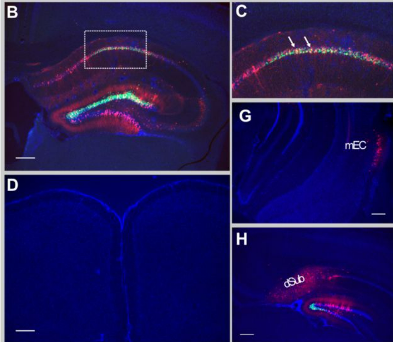This is the second in our series of posts highlighting the winners of the ASAPbio competition ‘Make your negative result a preprint winner,’ which celebrate the value of using preprints to share negative and inconclusive scientific results. In this post, we hear from Lilya Andrianova (University of Exeter Medical School & University of Glasgow), the first author of the preprint ‘No evidence from complementary data sources of a direct projection from the mouse anterior cingulate cortex to the hippocampal formation‘. Lilya tells us how a surprising published result in her field prompted her group to independently verify the finding, and why they chose preprints to quickly share the results from their replication study.
Tell us a little bit about the research project and results reported in the preprint.
A recently reported direct excitatory projection between two areas of the brain has altered the field of brain circuits. This result was very surprising and seemed to overturn years of anatomical research. We were working on a project to study indirect connections between these areas and sought to independently verify this newly-reported direct projection.

For anatomical tracing projects, such as this one, multiple methods, utilising the machinery of viral vectors are deployed. In this case we used both anterograde and retrograde adeno-associated viral vectors; a modified rabies virus and also did a data mining search on Allen projection atlas – an online depository of anatomical tracing data – to supplement our own data from another independent source. Our experiments failed to find any evidence that this direct projection existed.
Andrianova et al. Figure 2B-H.
What would you say is the most valuable contribution of your results to your community?
The most valuable contribution of this study is that it has provided a useful discussion of shortfalls in viral tracing methods. Being aware of these is of paramount importance, especially when searching for novel projections in the brain. With stereotaxic surgeries it’s important to consider spillage of the vector used into the neighbouring brain areas, especially the overlaying cortex. With many cortical regions sending projections to one another, it is surprisingly easy to observe false-positive results.
Why did the group decide to post a preprint with these results? Was this an easy decision for all the co-authors?
The lab believes that depositing preprints is a good strategy for gathering more feedback from the scientific community, and thus improve the manuscript even prior to submission to a journal. We also felt that it was important to share these results quickly to enable a wider discussion within the field; a preprint is the perfect way of sharing important results quickly that could otherwise be delayed by the publication process. Posting a preprint was an easy decision for us to take.
Did you submit the paper for publication in a journal?
Yes, the manuscript is currently under revisions in a journal, and will hopefully soon become a published article.
Would you encourage other researchers to write up negative results as preprints? How can we better recognize the value of negative results?
Absolutely! The authors are great proponents of publishing negative results. With the replication crisis in neuroscience research being upon us, it is important to share both positive and negative findings. Publishing a negative replication study can be of great use to the scientific community to find the discrepancies in the methodology of the articles, this can improve the reporting quality in the methods, and enable continued dialogue on the conclusions derived. It is also just as important to show to early career researchers that good quality data, even with a negative result, is worth reporting and publishing. Ultimately, someone else’s time could be saved by reporting a negative result. In a world with a limit on research resources, this is in everyone’s interest.
Don’t miss our next post in the series, where we will talk to Livia Songster, the author of the third winning preprint ‘Woronin bodies move dynamically and bidirectionally by hitchhiking on early endosomes in Aspergillus nidulans.’








